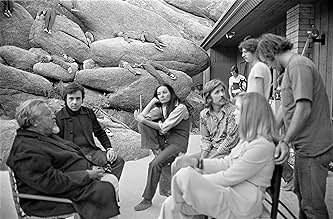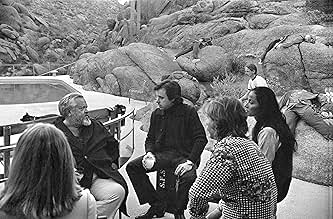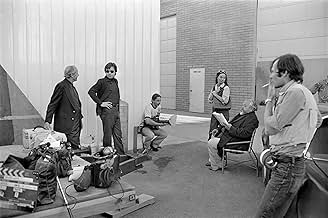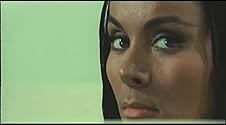CALIFICACIÓN DE IMDb
6.7/10
8.4 k
TU CALIFICACIÓN
Un director de Hollywood regresa tras un tiempo en las sombras para completar su trabajo en una innovadora película.Un director de Hollywood regresa tras un tiempo en las sombras para completar su trabajo en una innovadora película.Un director de Hollywood regresa tras un tiempo en las sombras para completar su trabajo en una innovadora película.
- Dirección
- Guionistas
- Elenco
- Premios
- 9 premios ganados y 8 nominaciones en total
Robert Random
- John Dale
- (as Bob Random)
- Dirección
- Guionistas
- Todo el elenco y el equipo
- Producción, taquilla y más en IMDbPro
Opiniones destacadas
I had the privilege of seeing this at the New York Film Festival. A sense of awe descended upon the audience as soon as the opening credits began. The fact that this film was finally completed and released is a triumph in and of itself.
Orson Welles' final film is chaotic and unwieldy, but also very haunting and melancholy. The soundtrack is amazing. There is frankly a sliver of a plot. An aging director attempts to make a comeback as Hollywood has drifted away from his era as he throws a big birthday party in which journalists, critics, admirers and some industry professionals join to celebrate. It soon becomes apparent that reporters are there to ascertain information about more than his work. His new film that is in the works is shown. We get to see an unfinished film within a film that is titled "The Other Side of the Wind", one that is sexually explicit.
The late John Huston portrays Jake Hannaford, the director whose approach to filmmaking has earned him a great following and his relationships with the actors he works with makes him a lightning rod of controversy. Huston's sepulchral voice and domineering presence make him flawless in the role as Hannaford. Peter Bogdanovich is well utilized as a younger, successful director whom Hannaford has taken under his wing but whom now Hannaford consults on how to better reach audiences of the new era.
This film is not flawless. The experience of seeing this at long last outweighs its drawbacks. There are some parts of this film that drag a bit. But there are also many, many scenes that are just astounding and I'm so happy they were finally brought to the big screen. Although this film is inconsistent in its narrative thrust, it returns very quickly to its busy, slightly manic state. I don't know if Welles deliberately left this unfinished. What I can say is that the editing is superb and provides us with a film that is a lasting testament to Welles and his legacy as a filmmaker. Highly recommended.
Orson Welles' final film is chaotic and unwieldy, but also very haunting and melancholy. The soundtrack is amazing. There is frankly a sliver of a plot. An aging director attempts to make a comeback as Hollywood has drifted away from his era as he throws a big birthday party in which journalists, critics, admirers and some industry professionals join to celebrate. It soon becomes apparent that reporters are there to ascertain information about more than his work. His new film that is in the works is shown. We get to see an unfinished film within a film that is titled "The Other Side of the Wind", one that is sexually explicit.
The late John Huston portrays Jake Hannaford, the director whose approach to filmmaking has earned him a great following and his relationships with the actors he works with makes him a lightning rod of controversy. Huston's sepulchral voice and domineering presence make him flawless in the role as Hannaford. Peter Bogdanovich is well utilized as a younger, successful director whom Hannaford has taken under his wing but whom now Hannaford consults on how to better reach audiences of the new era.
This film is not flawless. The experience of seeing this at long last outweighs its drawbacks. There are some parts of this film that drag a bit. But there are also many, many scenes that are just astounding and I'm so happy they were finally brought to the big screen. Although this film is inconsistent in its narrative thrust, it returns very quickly to its busy, slightly manic state. I don't know if Welles deliberately left this unfinished. What I can say is that the editing is superb and provides us with a film that is a lasting testament to Welles and his legacy as a filmmaker. Highly recommended.
Some films are hard to judge, especially something like this, that may be very close to what Welles intended, but never finished and never really seemed to be really satisfied with (see also the documentary about Welles from 2018, which is really good). Now there are things in here that may seem redundant to some or annoying. Or even pretentious to some extend. If that rings true to you or not, it doesn't mean you are right or wrong, one way or the other. It just means you have feeling and maybe knowledge and that's why you lean to a particular way or side.
Having written all that, I am surprised by the amount of nudity that made it into the film. I'm also surprised about the film depicting scenes being shot "in real time" with off commentaries by the director, with different cameras, cuts and all that. Now obviously we are taking creative liberties here and it's supposed to be heightened. It's to prove a point or even points. So in a way there is more to the film than meets the eye. You have to approach this movie with a certain mindset.
If you do that, you may be able to see more than some others. But if you don't you'll probably be bored. Whatever your stance on this is and it will be dividing, you cannot call this an easy movie to watch. Some probably will watch it multiple times and cherish it's commentary and behind the scenes insights as much as its psychology. Others will just sneer at the mention of the title. In a way I'd say that would make Welles happy after all ...
Having written all that, I am surprised by the amount of nudity that made it into the film. I'm also surprised about the film depicting scenes being shot "in real time" with off commentaries by the director, with different cameras, cuts and all that. Now obviously we are taking creative liberties here and it's supposed to be heightened. It's to prove a point or even points. So in a way there is more to the film than meets the eye. You have to approach this movie with a certain mindset.
If you do that, you may be able to see more than some others. But if you don't you'll probably be bored. Whatever your stance on this is and it will be dividing, you cannot call this an easy movie to watch. Some probably will watch it multiple times and cherish it's commentary and behind the scenes insights as much as its psychology. Others will just sneer at the mention of the title. In a way I'd say that would make Welles happy after all ...
A famed, and infamous, movie director, JJ Hannaford, dies in a car accident. He was about to release his latest movie and a documentary camera crew had been following him around in the days preceding his death. We see the events leading up to his death, the careers Hannaford destroyed, the enemies he made and his last film, The Other Side of the Wind.
Written and directed by the great Orson Welles, this movie has taken nearly 50 years to be released. Welles started shooting it in 1970 and by his death in 1985 it had not been released. Production issues and politics prevented this. Now, in 2018, Netflix has released it. Being a huge fan of Orson Welles, the thought of seeing his long-dormant final film released was an exciting one.
However, the final product is quite disappointing. It looks and feels unfinished, a mashup of random scenes. While watching I thought that this was due to the film being in an unedited state when Welles died and it was edited to the final version after his death. Turns out the final version had already been edited by Welles, so we can't blame Netflix's production team.
The film-within-a-film element was initially intriguing but is ultimately confusing. What is part of Hannaford's film and what is Welles's film? Are the pretentious, trippy, hippy sequences and the gratuitous nudity and sex scenes Welles trying to appeal to early-70s arty audiences or his take on the pretentiousness of modern movies?
I would like to think that one of the themes of the movie is the pretentiousness of Hollywood, so will give Welles the benefit of the doubt on the content. However, it does become a jarring, disconcerting experience when you have seemingly-gratuitous scenes like those thrown randomly into the movie.
This said, it is not all bad. Welles's take on Hollywood, its movies and the pretentiousness of the times is well directed (if, indeed, that was his aim. It's so difficult to tell). The mystery surrounding John Dale adds intrigue. The story of JJ Hannaford is interesting and John Huston is perfect in the role. He pretty much just had to play himself!
Even here, however, Welles overeggs the pudding. I would have been more engaged in the Hannaford story if there weren't so many scenes that added nothing to plot or character development. So many scenes that just take up space and so much long, pointless dialogue. There's no momentum to the movie at all and the ending is a damp squib.
Written and directed by the great Orson Welles, this movie has taken nearly 50 years to be released. Welles started shooting it in 1970 and by his death in 1985 it had not been released. Production issues and politics prevented this. Now, in 2018, Netflix has released it. Being a huge fan of Orson Welles, the thought of seeing his long-dormant final film released was an exciting one.
However, the final product is quite disappointing. It looks and feels unfinished, a mashup of random scenes. While watching I thought that this was due to the film being in an unedited state when Welles died and it was edited to the final version after his death. Turns out the final version had already been edited by Welles, so we can't blame Netflix's production team.
The film-within-a-film element was initially intriguing but is ultimately confusing. What is part of Hannaford's film and what is Welles's film? Are the pretentious, trippy, hippy sequences and the gratuitous nudity and sex scenes Welles trying to appeal to early-70s arty audiences or his take on the pretentiousness of modern movies?
I would like to think that one of the themes of the movie is the pretentiousness of Hollywood, so will give Welles the benefit of the doubt on the content. However, it does become a jarring, disconcerting experience when you have seemingly-gratuitous scenes like those thrown randomly into the movie.
This said, it is not all bad. Welles's take on Hollywood, its movies and the pretentiousness of the times is well directed (if, indeed, that was his aim. It's so difficult to tell). The mystery surrounding John Dale adds intrigue. The story of JJ Hannaford is interesting and John Huston is perfect in the role. He pretty much just had to play himself!
Even here, however, Welles overeggs the pudding. I would have been more engaged in the Hannaford story if there weren't so many scenes that added nothing to plot or character development. So many scenes that just take up space and so much long, pointless dialogue. There's no momentum to the movie at all and the ending is a damp squib.
Here it is, if anybody wants to see it.
Were you compelled by the character study of Citizen Kane? Were you thrilled by Touch of Evil? Then get ready for something unlike any of those or unlike anything. This is the mockumentary before Reiner or Guest, the improvisational dramedy before Apatow.
The entire point of this movie is that there's no point to this movie. Here is Orson Welles's most talked about movie about talking about a movie. His film about a film within a film. Orson Welles deliberately subverts Orson Welles to make an art film contained within an art film making fun of art films. John Huston plays John Huston playing Orson Welles as Orson Welles. Peter Bogdanovich plays himself as his own ripoff. There's a party celebrating a celebrated filmmaker making a film making fun of filmmakers. Nothing happens. So much happens. We learn everything about a legendary director about whom we learn nothing.
This film is a glimpse into the psyche of a filmmaker who wants to make films but has no idea how to keep making films. He wants to be commercially successful without compromising his integrity. He wants to make personal films for an impersonal audience. He wants to make something sexy despite being prudish. This movie isn't really for anyone; this movie is really for everyone.
It wasn't until the end of his life that Orson Welles realized the most important story he needed to tell was his own. It's a story whose only concern is that it was told, whether or not you like it. So watch it. Or don't. This movie doesn't care either way.
And if this review left you feeling confused, then I gave you an accurate impression of the film.
Were you compelled by the character study of Citizen Kane? Were you thrilled by Touch of Evil? Then get ready for something unlike any of those or unlike anything. This is the mockumentary before Reiner or Guest, the improvisational dramedy before Apatow.
The entire point of this movie is that there's no point to this movie. Here is Orson Welles's most talked about movie about talking about a movie. His film about a film within a film. Orson Welles deliberately subverts Orson Welles to make an art film contained within an art film making fun of art films. John Huston plays John Huston playing Orson Welles as Orson Welles. Peter Bogdanovich plays himself as his own ripoff. There's a party celebrating a celebrated filmmaker making a film making fun of filmmakers. Nothing happens. So much happens. We learn everything about a legendary director about whom we learn nothing.
This film is a glimpse into the psyche of a filmmaker who wants to make films but has no idea how to keep making films. He wants to be commercially successful without compromising his integrity. He wants to make personal films for an impersonal audience. He wants to make something sexy despite being prudish. This movie isn't really for anyone; this movie is really for everyone.
It wasn't until the end of his life that Orson Welles realized the most important story he needed to tell was his own. It's a story whose only concern is that it was told, whether or not you like it. So watch it. Or don't. This movie doesn't care either way.
And if this review left you feeling confused, then I gave you an accurate impression of the film.
Years ago I saw a documentary that included a scene from a never-released Orson Welles film, The Other Side of the Wind. It was remarkably modern, a kaleidoscopic, eccentric work that was surprising for someone Welles age.
It wasn't until 2020 that I learned the film had actually been pulled together and released.
The cinema-verite style is explained as the result of pulling together footage from various documentarians and journalists video. The film begins with various hangers on of a famous director traveling to his party while elsewhere an investor is watching footage from his current, unfinished film.
This is actually the weakest part of the movie. The individual scenes are confusing and the way they are intercut with the film-within-a-film just add to the confusion. Apparently Welles had rough-cut about half the movie by the time he died, and my suspicion is this first part was not part of that rough cut, since it's weaker. Just a guess.
The film-within-a-film seems to be a parody of trippy, avant-garde, 60s filmmaking. I take it as Welles' portrayal of an old director past his glory days trying to create something hip.
The movie gets its footing when the director's party starts. There is a lot of striking B&W footage cut in and John Huston as the director is a powerful force. The party is to screen his movie, such as it is, and while it is essentially a plotless bit of nonsense with tons of gratuitous nudity, it does have some striking imagery, such as a scene set in slatted shadows and another involving a beaded necklace.
The surrounding film doesn't have much story. It's mainly about the director charming or dueling with various characters who want something from him. Things are hinted but rarely spelled out.
Welles was a genius, so even his worst movies, like Mr. Arkadin, are splashed with brilliance. Other Side of the Wind has a remarkable style and is generally fascinating, but it's not always satisfying and the film-within-a-film takes up more time than it probably should have.
If you're a fan of Orson Welles, or just a fan of cinema, this is a must-see. Yes, the movie would have been more impressive if it had been released in the early 70s, when it was filmed, but even today in a world full of found-footage movies this is still remarkable.
It wasn't until 2020 that I learned the film had actually been pulled together and released.
The cinema-verite style is explained as the result of pulling together footage from various documentarians and journalists video. The film begins with various hangers on of a famous director traveling to his party while elsewhere an investor is watching footage from his current, unfinished film.
This is actually the weakest part of the movie. The individual scenes are confusing and the way they are intercut with the film-within-a-film just add to the confusion. Apparently Welles had rough-cut about half the movie by the time he died, and my suspicion is this first part was not part of that rough cut, since it's weaker. Just a guess.
The film-within-a-film seems to be a parody of trippy, avant-garde, 60s filmmaking. I take it as Welles' portrayal of an old director past his glory days trying to create something hip.
The movie gets its footing when the director's party starts. There is a lot of striking B&W footage cut in and John Huston as the director is a powerful force. The party is to screen his movie, such as it is, and while it is essentially a plotless bit of nonsense with tons of gratuitous nudity, it does have some striking imagery, such as a scene set in slatted shadows and another involving a beaded necklace.
The surrounding film doesn't have much story. It's mainly about the director charming or dueling with various characters who want something from him. Things are hinted but rarely spelled out.
Welles was a genius, so even his worst movies, like Mr. Arkadin, are splashed with brilliance. Other Side of the Wind has a remarkable style and is generally fascinating, but it's not always satisfying and the film-within-a-film takes up more time than it probably should have.
If you're a fan of Orson Welles, or just a fan of cinema, this is a must-see. Yes, the movie would have been more impressive if it had been released in the early 70s, when it was filmed, but even today in a world full of found-footage movies this is still remarkable.
¿Sabías que…?
- TriviaThe movie was filmed between 1970 and 1976, with editing continuing into the 1980s. When he died in October 1985, Welles left behind nearly 100 hours of footage and a work print consisting of assemblies and a few edited scenes.
- ErroresIn one confrontational scene, Brooks Otterlake, who Gregory Sierra's character, Jack Simon, refers to as, "Kid", is simultaneously Peter Bogdanovich and Rich Little. This is small overlap is because Rich Little was originally cast as the black turtleneck wearing, voice imitating director, Brooks Otterlake. However Bogdanovich replaced him, and Little's part was reduced to that of a Party Guest.
- Citas
[last lines]
Jake Hannaford: Who knows, maybe you can stare too hard at something, huh? Drain out the virtue, suck out the living juice. You shoot the great places and the pretty people... All those girls and boys. Shoot 'em dead.
- Créditos curiososAfter the end credits, Hannaford's voice is heard saying "Cut"
- ConexionesFeatured in AFI Life Achievement Award: A Tribute to Orson Welles (1975)
- Bandas sonorasLes Délinquants
Written and performed by Michel Legrand
Published by WB Music Corp. o/b/o Productions,
Michel Legrand + Editions Royalty
Courtesy of Decca Records France
Under license from Universal Music Enterprises
Selecciones populares
Inicia sesión para calificar y agrega a la lista de videos para obtener recomendaciones personalizadas
- How long is The Other Side of the Wind?Con tecnología de Alexa
Detalles
- Fecha de lanzamiento
- Países de origen
- Sitio oficial
- Idiomas
- También se conoce como
- Phía Bên Kia Cơn Gió
- Locaciones de filmación
- Productoras
- Ver más créditos de la compañía en IMDbPro
- Tiempo de ejecución
- 2h 2min(122 min)
- Color
- Mezcla de sonido
Contribuir a esta página
Sugiere una edición o agrega el contenido que falta





































